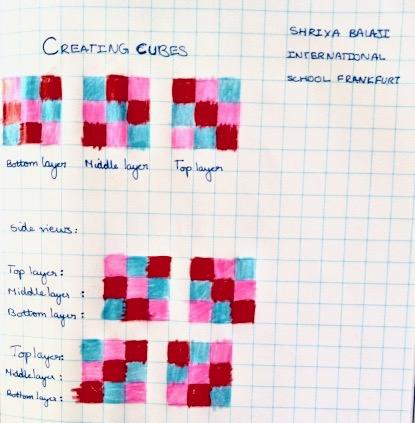Creating cubes
Arrange 9 red cubes, 9 blue cubes and 9 yellow cubes into a large 3 by 3 cube. No row or column of cubes must contain two cubes of the same colour.
Problem
Arrange nine red cubes, nine blue cubes and nine yellow cubes into a large $3$ by $3$ cube.
No row or column of cubes can contain two cubes of the same colour.

In the picture, the top face and the right face have one of each colour.
However, the third face has two columns which contain two cubes of the same colour, so this is not correct.
You may like to try Nine Colours once you've had a go at this task.
Printable NRICH Roadshow resource.
Getting Started
It would be good to use some interlocking cubes to try out your ideas.
Student Solutions
Rugile, Rihards-Renars, Shane, Keeley and Matas from Orchards Primary School sent in:
First, we got the cubes and made a column of 1 red, 1 blue and 1 yellow cube. Then we made the second column, we made sure that each cube was not in the same row as another cube of the same colour. For the third column (to complete 1 face) we repeated this method by putting the cubes in a different formation.
After that, we repeated this pattern but changed the formation of colours each time to make sure that there was not more than 1 colour in any column or row of the cube.

From Chestnut Class, also from Orchards School:
So we put the cubes into a pattern. Then we put one of each colour in a row. At the top there's four blues, four reds and one yellow. The yellow is in the middle. The four blues are in every corner and the reds are across. Right in the middle is a yellow cube. The yellows formed a cross in the middle of the cube. Here are two pictures showing the top and the
bottom of the cube.
See the pictures above
Nathan from Bishop Wood School sent in a different kind of solution
Say your three colours are red (R), green (G) and white (W). You are looking at the front face of your cube and the colours are: top-left (t-l) R, top-middle (t-m) W, top-right (t-r) is G, middle-left (m-l) is W, middle-middle (m-m) is G, middle-right (m-r) is R, bottom-left (b-l) is G, bottom-middle (b-m) is R and bottom-right (b-r) is W. In the middle layer: t-l is G, t-m is R, t-r is W, m-l is R, m-m is W, m-r is G, b-l is W, b-m is G, b-r is R. Finally the layer away from you is then: t-l is W, t-m is G, t-r is R, m-l is G, m-m is R, m-r is W, b-l is R, b-m is W and b-r is G. This cube would work as you will see if you look at the images that the same position on different images are always different colours (E.G t-l in image one is a different colour to t-l in image two and t-l in image three is a different colour). Try making this cube for yourself!
By Nathan Townsend
(Year six student at Bishop Wood School)
Shriya from the International School Frankfurt in Germany sent in this:

Magnus, Micah and Sam from Albyn School Aberdeen in Scotland sent in this solultion:
We started with the top face. We worked from the bottom of the face upwards and created a pattern where red goes on yellow, black goes on red and yellow goes on black. This means that no identical colours are in the same row or column. We had one colour go diagonally across each face. Tip: if the same colour cubes have to touch, make them diagonally opposite each other.
A teacher from Dussindale Primary sent in this from Harry and Hiten of Drake Class Y6 who completed the task - they were really fast too and solved it in less than 15 minutes.

Teachers' Resources
Why do this problem?
Possible approach
Key questions
Possible extension
Possible support
Working in pairs would offer support for learners and also give them the opportunity to talk through their strategies.
